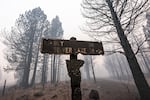As the nation’s largest wildfire neared 400,000 acres burned on Thursday, nine firefighters assigned to the blaze tested positive for COVID-19. That’s prompted state health officials to work with incident management teams to set up quarantine areas away from fire camps, though officials also noted that they had already taken steps to minimize transmission risk after developing pandemic response plans during last year’s wildfire season.
“This fire season has been slightly different due to the broad availability of vaccines and the prioritization of structural and wildland firefighting resources for vaccination in the spring,” incident managers wrote in a statement announcing the outbreak. “However, many of last year’s COVID-19 exposure mitigation measures are still in use at fire camps statewide.”
Related: Oregon prepares to fight wildfire during coronavirus pandemic
With an estimated 2,359 personnel assigned to the south-central Oregon firefighting effort, the coronavirus diagnoses announced Thursday amount to a small fraction of the total crew size. The Oregon Health Authority is treating the new COVID-19 cases as part of a workplace outbreak.
Thursday afternoon reports said the Bootleg Fire remained roughly 399,359 acres and 38% contained, making it the third-largest wildfire and second-largest forest fire to burn in Oregon since 1900.
It will likely continue to grow. The Northwest Interagency Coordination Center issued a fuel and fire behavior advisory for central and south-central Oregon, where the Bootleg Fire is currently burning. Fuels are expected to stay extremely dry until at least Aug. 2.
“Potential for extreme fire behavior exists due to critically low live and dead fuel moistures, very dry conditions from an extended drought, and a recent record-breaking heat wave,” the report says.

A sign damaged by the Bootleg Fire stands among the haze on Thursday, July 22, 2021, near Paisley, Ore.
Nathan Howard / AP
The report also notes that this low fuel moisture is abnormal for this time of year. Usually, moisture levels this low aren’t seen for two to three more weeks. Several monitoring stations in the area haven’t seen any rain for 30 days. Fire crews are seeing behavior “compared to peak August burning conditions seen in very dry years,” according to the NWCC report.
Here’s a look at the major fires in the region and other related news items:
Bootleg Fire: Fire growth slowed somewhat as morning cloud cover and increased humidity aided firefighting efforts, but that extra moisture was expected to burn off as the day progresses.
”Fire crews have made significant progress in containing this fire over the last few days,” said Joe Prummer, an incident commander trainee assigned to the fire. “However, we still have a long road ahead of us to ensure the safety of surrounding communities.”
The fire slowed somewhat as it entered previously-burned areas. Some areas, near Sycan Marsh Preserve, were managed with controlled burning. Crews reported that in those areas, the fire left the trees, and burned along the ground. The fire also slowed as it entered an area previously burned by the Watson Fire in 2018.
The progress made on containment prompted officials to lower evacuation levels for some parts of Klamath County Wednesday afternoon. Current evacuation information is available here.
Elbow Creek Fire: The Elbow Creek fire grew to 19,993 acres on Thursday, making it Oregon’s second-largest fire. It was 20% contained. The fire became more complex Tuesday and Wednesday, prompting the assignment of six additional crews to the fire. Twelve additional crews arrived Wednesday night, and orders were placed Thursday for more resources.
The most active area of the fire Thursday was near the Grande Ronde River at the intersection of several canyons that produce erratic winds from all directions. Steep slopes along Indian Ridge and Grossman Creek are also creating challenging conditions for firefighters.
Level 3, or “go now,” evacuations are in effect for the Eden Bench and Promise communities. Current evacuation information is available here.
Lightning sparks more western fires
According to the U.S. Forest Service,, storms caused over 600 lightning strikes Wednesday across eastern Oregon and Washington. Thunderstorms this time of year are a frequent cause of wildfires. It may take days for fires from those lightning strikes to ignite, if they ever do, but they come at a time when resources to fight fires are extremely limited.
Smoke from wildfires burning in California, Oregon, Washington and British Columbia turned skies red along the U.S. East Coast, after smoke travelled over 3,000 miles and settled over the area. Smoke over the region has caused “unhealthy’ air quality from the Mid-Atlantic north. The last time New York City saw air quality this bad was 2006.
British Columbia has declared a state of emergency, as nearly 300 wildfires burn across the Canadian province.
Power problems
In California, utility company Pacific Gas & Electric has announced plans to bury over 10,000 miles of power lines. PG&E’s electrical grid has been fingered as the cause of a number of destructive wildfires in California. Lawsuits resulting from those fires led the company to file bankruptcy in 2019, and the utility was also blamed for starting wildfires in 2020.
Some of Oregon’s destructive 2020 Labor Day fires were caused or worsened by downed power lines. Residents of the Santiam Canyon have entered into a lawsuit against Pacific Power, the company that provides power to many of the area’s towns, and which failed to cut off power in advance of the Labor Day windstorm.